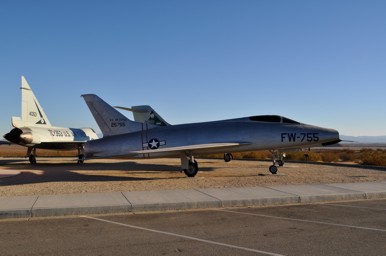
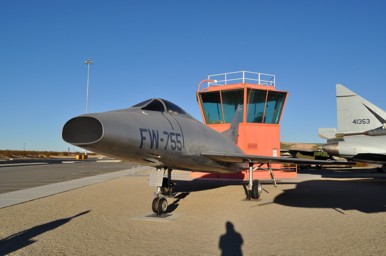


 |
 |
 |
 |
The
first The second YF-100A (52-5755) is on display in the
"Century Circle" just outside the main gate at Edwards
AFB. This photo was taken late in the day 4 November,
2012. Originally the Super Sabre had a taller
tail than the F-100A when it entered production. It
also lacks the "inside out" rudder that became a hallmark of
the F-100 Super Sabre line.
On display at Lackland AFB is this very
early F-100A (52-5759), photographed in September, 2000.
52-5773 is another F-100A, this one being displayed outside
the Confederate, er, sorry, the "Commemorative"
Air Force" in Midland, TX in September, 2007.
Note that all of these aircraft are missing the nose
probes. That seems to be rather common with Huns on
outdoor display.
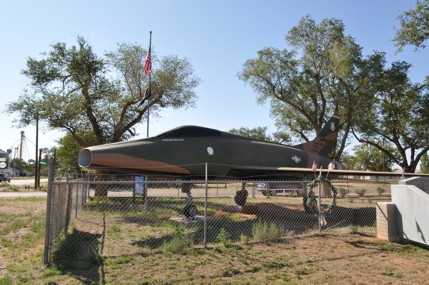 |
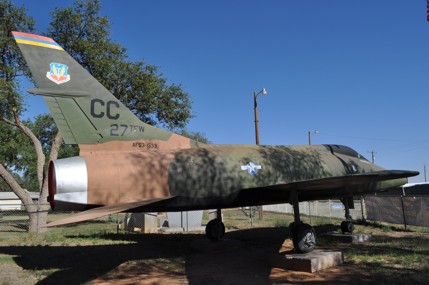 |
 |
 |
Photographed on September 23, 2011 F-100A 53-1533 is painted in the markings of the
27th Tactical Fighter Wing and displayed in Melrose, New
Mexico. The 27th flew F-100D and F-100F versions of
the Hun, not F-100A models.
F-100A 53-1600 is on display in Tucumcari, NM. Photographed the same day as 1533, it is not in nearly the same condition.
 |
 |
 |
 |
 |
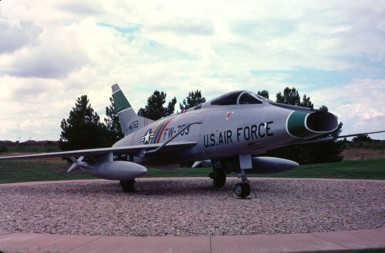 |
 |
The 188th TFS, New Mexico Air
National Guard, was one of the last units to fly the F-100C,
converting to the A-7D in 1973. F-100C 54-1752 as it
appeared at MASDC in 1979 with the "Tacos"
wheeled road runner on the tail. This aircraft was
later repainted as "54-1753" in the markings of the 322nd
Fighter Day Group before being placed on display at Dyess
AFB. The two middle photos of her were taken in
August, 2001 and the last one in May, 2010.
 |
 |
The actual "753" as displayed at the
National Museum of the United States Air Force
(NMUSAF). This aircraft was christened the "Susan Constant"
while with the 322nd Fighter Day Group, Foster AFB,
Texas. This aircraft has left the Air Force Museum and
by 2004 was on display at the Southern Museum of Flight in
Birmingham, Alabama where unfortunately this colorful scheme
has deteriorated considerably.
 |
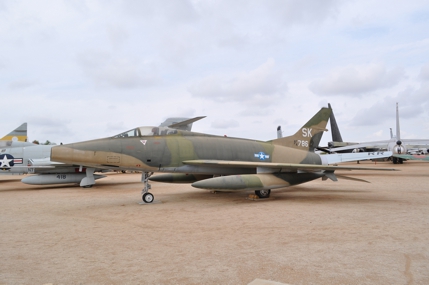 |
 |
F-100C 54-1786 on
display at the March Field Museum, March Air Reserve Base, CA.The
current scheme represents the aircraft when she deployed to
Tuy Hoa Air Base, Republic of Vietnam in 1968. At that
time the 188th TFS New Mexico Air National Guard was activated
and attached to the 31st TFW. This is an an accurate
scheme for this airplane. Prior to that she had been
marked to represent an aircraft of the 308th TFS/31st TFW
(right). The 308th had been equipped with F-100D and F-100F
Super Sabres.
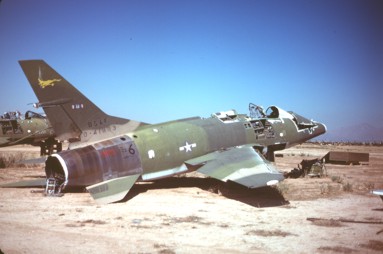 |

|
Good Huns gone bad... F-100C
54-1803, MASDC 1979. In happier days, she had
served with the NM ANG. Sometime after this she was
exported to Turkey where supposedly she is on display at Sivrihisar.
 |
 |
 |
 |
 |
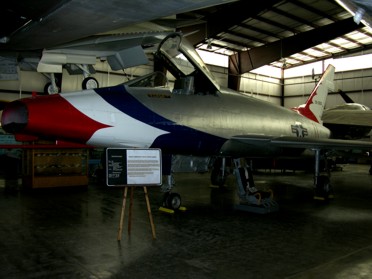 |
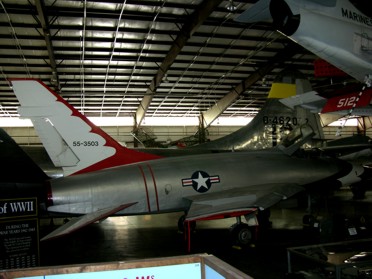 |
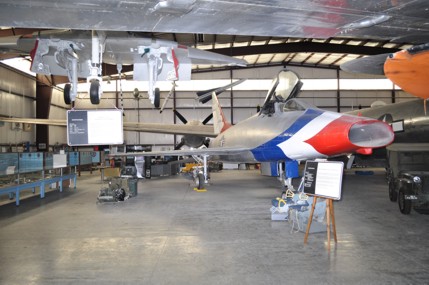 |
 |
 |
 |
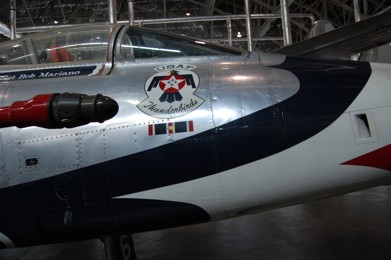 |
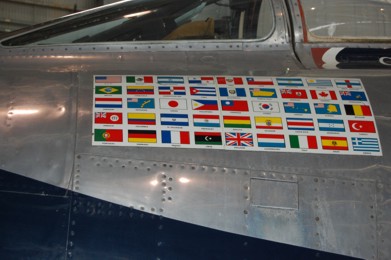 |
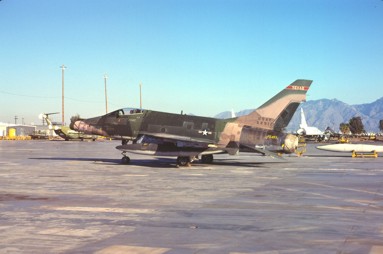 |
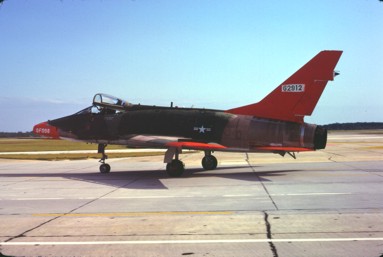 |
 |
F-100D 56-2912 (Left) as she
appeared in 182nd TFS (TX ANG) markings when photographed at
MASDC in 1979, when she was being removed from storage for
conversion to a QF-100. In October 1982 she was
at Tyndall AFB (center). By 1984 912 was based at
Holloman AFB. (Bobby Porter)
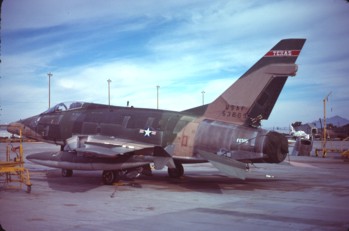 |
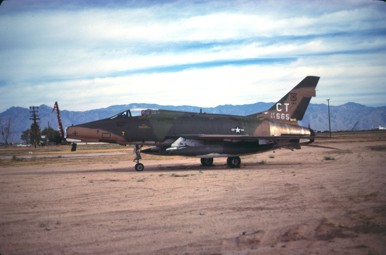 |
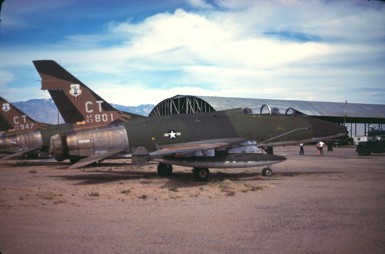 |
F-100D 55-3665
of the 182nd TFS (TX-ANG) at MASDC in October, 1979.
The 118th TFS,
Connecticut ANG repainted the tan in the camo to form a
bird's head as a unique marking. The F-100D (55-3665)
has a more elaborate blue eyed bird, while the F-100F
(56-3801) is slightly more plain.
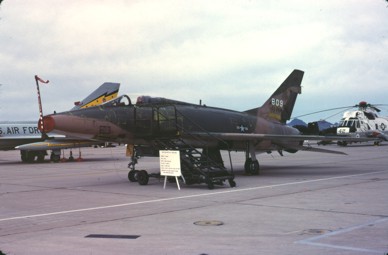 |
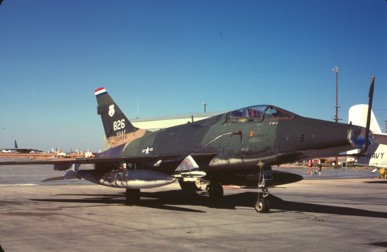 |
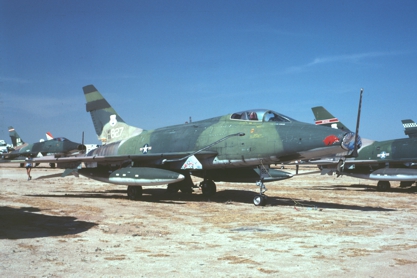 |
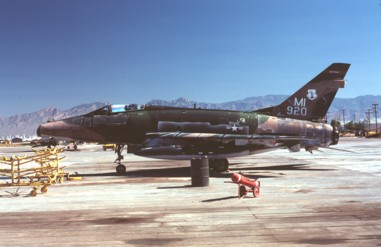 |
F-100D 55-2809, ex 175th TFS, SD ANG, on
display at the 1982 Davis Monthan open house.. This
aircraft was being "prepped" for QF-100 conversion.
F-100D 56-2826, 113th TFS, Indiana ANG,
MASDC 1979.
F-100D
56-2827 184th TFS Arkansas ANG. MASDC 1979.
F100D 56-2920 107th TFS, Michigan ANG.
MASDC 1979.
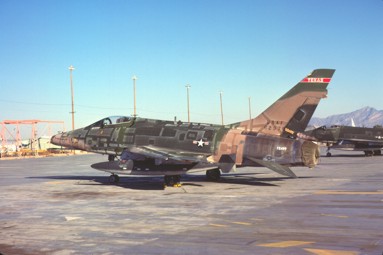 |
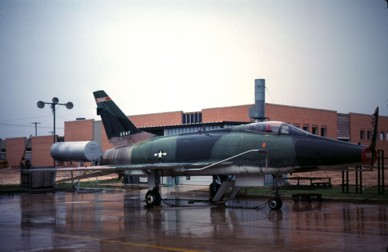 |
 |
 |
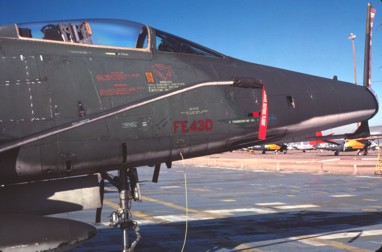 |
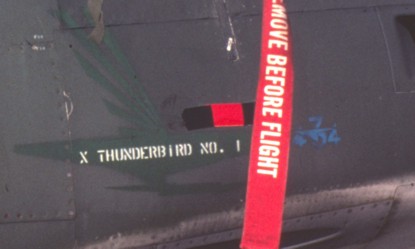 |
F-100D 56-3093
128th TFS Georgia ANG. An inscription on the nose of 893
reads "X THUNDERBIRD NO. 1", but in actuallity it never served
with the Thunderbirds. At some point the tail was
damaged and replaced with the tail of a former T-Bird number
one aircraft. The green bird on the nose is a 49th FIS
zap. She has been zapped by 434 Squadron RCAF as well.
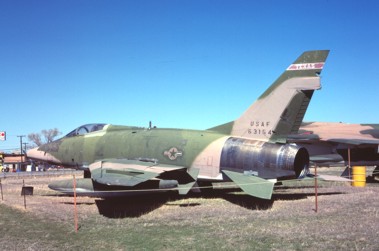 |
 |
 |
 |
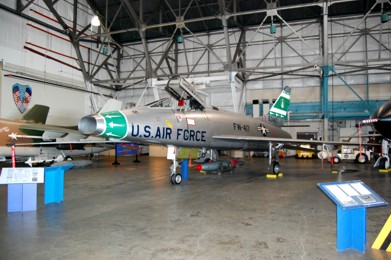 |
 |
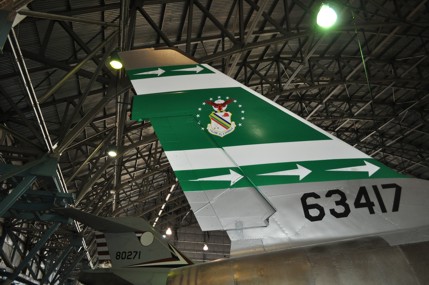 |
 |
 |
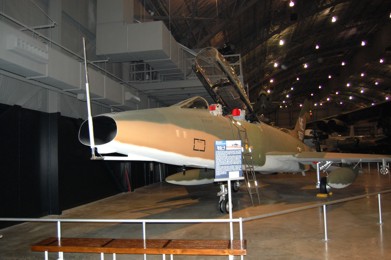 |
 |
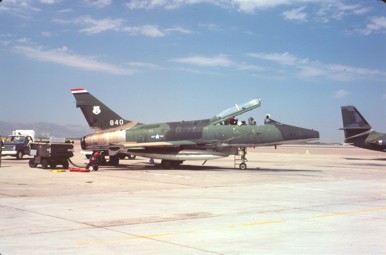 |
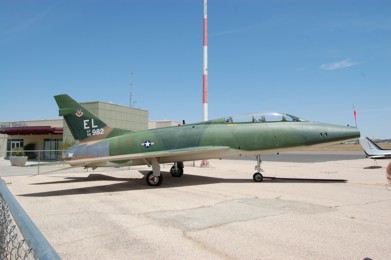 |
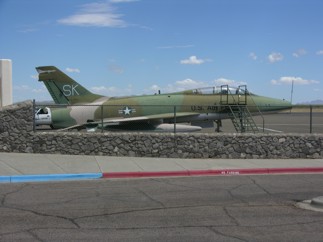 |
 |
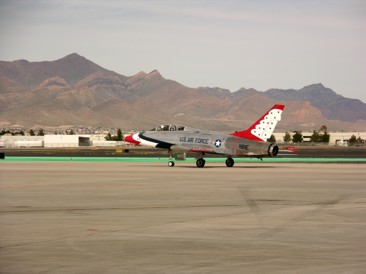 |
The ultimate
Warbird... F-100F 56-3844 (N26AZ), painted in the markings
of the 188th FIS, NM ANG. This Hun is based at the El
Paso International Airport. (Photo: Jack
Callaway) 3844 has later repainted in Thunderbird
markings as in this 2005 photo. In 2011 she was sold
to the Collins Foundations and is sometimes flown at
airshows.
 |
 |
Another Hun on
the civil registry is this F-100F, 56-3948. The first
photo shows her at Mojave, California in 1989 after
importation for the QF-100 program. She was not
converted and was later sold on the civilian market.
The second photo was taken by Jack Callaway at the El Paso
International Airport in March, 1999. She still
carries the registraion of N2011V.
 |
 |
 |
 |
The same F-100F one year apart:
56-3904 at Holloman AFB in October, 1991 while part of the
QF-100 program and a year later at Holloman while flying
with the U.S. Army for use in missile development.
 |
 |
56-3905 was
another two seat Hun operated by the Army, photographed at
Holloman in October, 1993. After the end of the F-100
drone program some airframes became display aircraft.
This two seater
(56-3812) is displayed in Duncan, AZ.
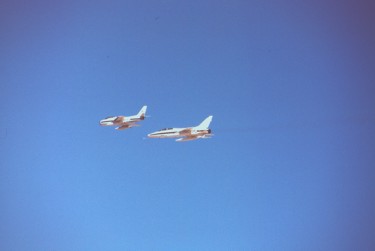 |
 |
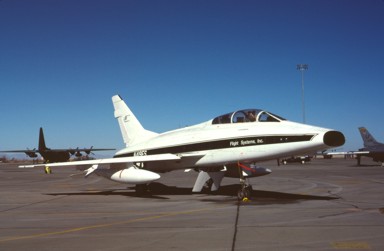 |
Flight Systems
inc operated several F-100s for target duties. F-100F
56-3971 (N419FS) was photographed in formation with a Flight
Systems F-86F (N89FS) at Holloman AFB in October, 1988 and
again on the ground in October, 1995.
 |
F-100C 54-1951 of the 4758th Defense
Systems Evaluation Squadron over Southern New Mexico.
The 4758th DSES flew F-100Cs and Fs (along with B-57s) from
Biggs AFB until 1966. The Huns were a common site in
the skies over El Paso during that time and flew over my
house when I was a small child. One of my earliest
airshow memories is of my brother threatening to stuff me
into the intake of a Hun. (USAF)
What started as the F-100B, became the F-107A.
 |
 |
 |
 |
 |
 |
During the time frame that many of these photos were taken,
the storage facility at Davis-Monthan AFB, Arizona, was
referred to as the Military Aircraft Storage and Disposition
Center (or MASDC). Sometime in the 1980s the name
became the Aerospace Maintenance and Regeneration Center
(AMARC). More recently it has changed to 309th
Aerospace Maintenance and Regeneration Group
(AMARG). This is what many people call "the
Boneyard". The photos on this page and others that
show MASDC in the caption were taken there.
 |
 |
 |
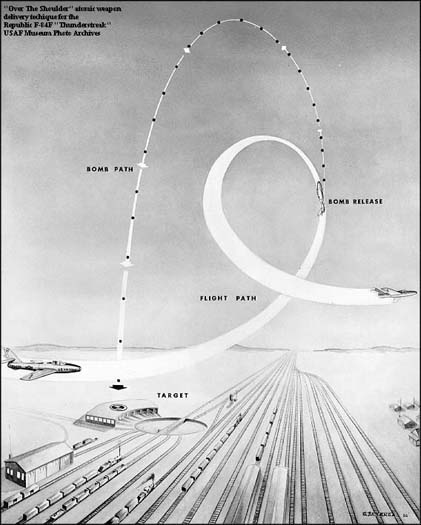 |
Starting
with the F-100C delivery of nuclear weapons became one
of the F-100's primary missions. The weapon types
usually mentioned for the Hun include the Mark 7, B28EX,
B28RE, B43, B57 and the B61. The first photo above
shows a Mark 7 carried on the left inboard station.,
which was the rule for that weapon. The later
marks were carried on the center line. The second
photo shows an F-100D delivering a B28RE. The
third photo is an F-100C performing a "Low Altitude
Bombing System" (LABS) maneuver. And the final
photo is an illustration of the LABS maneuver.
 |
 |
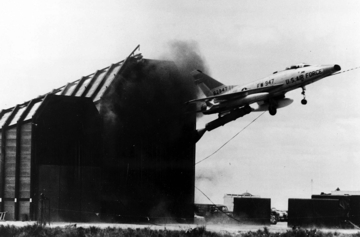 |
NATO
had concerns about the survivability of runways in the
event of war with the Warsaw Pact nations. To
address the "ZEL" (Zero Length) system was devised where
a nuke armed airplane could be launched without the need
for runways. This was just a large rocket engine
attached to the belly of the aircraft that would
accelerate it off of a special trailer. The
booster would fall away and the aircraft continue on to
its target. The system was tested on straight wing
F-84s and could be used with F-84Gs, F-100s and
F-104s. Specials sheds were developed to house the
aircraft that were "cocked and ready". Though
successful for whatever reason it was never adopted in
numbers. The Soviet Union tested a similar setup
on MiG-19s.
In the first two photographs above we see 56-2904 at
Edwards AFB prior to launch and just after
launching. In both photo there is a Mark 7 "shape"
under the left wing. The last photo shows 56-2947
launching from a protective shed at Holloman AFB.
It too carries a Mk.7 shape. The shed in that
photo is still in existence at Holloman.
 |
 |
 |
 |
The tail of the YF-100A Super Sabre was taller than the tail that was used on the first production F-100A airframes. It also had a solid rudder rather than the one with external ribs used on later airplanes.
The
tail chosen for production was reduced in height, which
unfortunately also reduced stability. This was a
contributing factor in several crashes, including the
one that killed George Welch. This aircraft while
sporting the shorter fin does not have the same rudder
as used on later production F-100A's.
The
fin that was later used in production of F-100A and
F-100C Super Sabres (and retrofitted to earlier
aircraft) was increased approximately two feet in
height. This photo also shows the rudder with
external ribs.
The final fin was used by F-100D and F-100F Super Sabres. It was both slightly taller and slightly thicker in chord. The fairing covering the fuel dump is also larger.
 |
Through the engine:
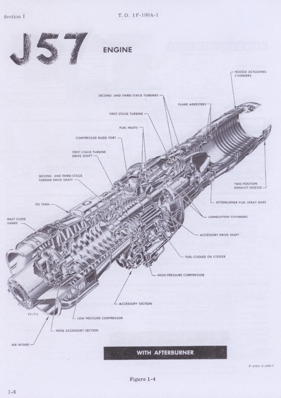 |
The J57 was used for a good number of the Century
Series: F-100, F-102, F-101 and the Navy F-8.
To the exhaust:
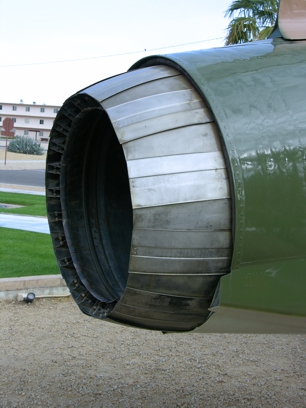 |
 |
 |
The original afterburner for the F-100 Super Sabre
was made of several "petals" that slide together to
open and close afterburner nozzle. These would
often bind and the burner would not light correctly,
or function properly. To alleviate this
afterburner sections from F-102s were used in place
of the originals. This was possible as both
the Hun and the Deuce used versions of the J57
engine.
 |
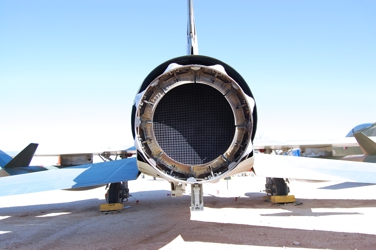 |
 |
The F-102 afterburner was first used by Air National
Guard units and became the norm in later
years. The screen visible inside the exhaust
in the second photo is to keep birds from nesting
inside. The three photos are of an F-100C
(54-1823) on display at the Pima Air & Space
Museum.
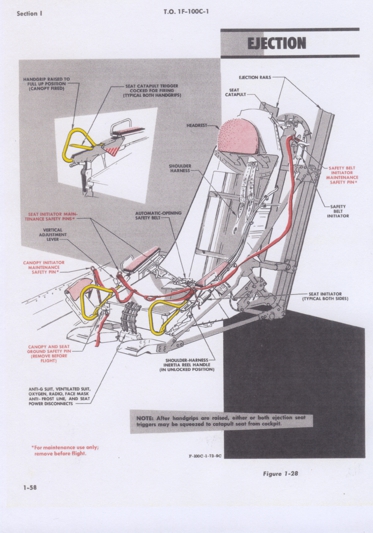 |
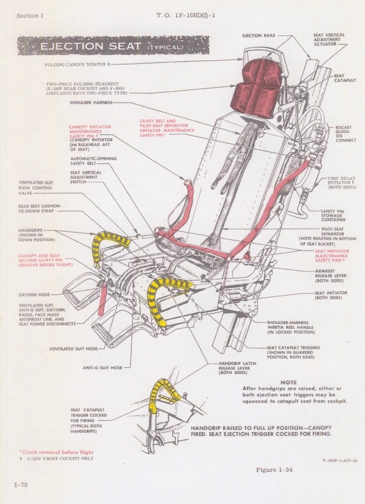 |
F-100C and F-100D ejection seat illustrations from
the F-100 Flight Manuals.
| Model |
Length |
Wingspan |
Height |
Hard Points |
|
| Probe Folded
Probe Extended |
Original
Production |
||||
| YF-100A |
46' 2" 47'1" |
36'9" | 14'5"
14'5" |
5 |
|
|
F-100A |
47'*
53'11" |
38'9" |
13'4"
15'6" |
5 |
|
|
F-100C |
47'*
53'11" |
38'9" |
15'6" |
7 |
|
|
F-100D |
47'9"*
54'3" |
38'9" |
16'3" |
7 |
|
|
F-100F |
52'6"
57'2" |
38'9" | 16'3" |
7 |
* The difference in length between the F-100A/C
and the F-100D is due to the overhang of the
larger (and taller) tail of the F-100D. The
Actual length from the lip of the
intake to the trailing edge of the after burner is
44'5" for all three.
For an airplane that has had as much written about it
as the Hun it is rather odd that finding accurate
dimensional data is rather difficult. The Flight
manual, often called the "Dash one", has different
dimensions than the "Standard Aircraft
Characteristics" (SAC) chart. Many published
sources also differ. In the end I used data from
the T.O. 1F-100C-2-1 and the T.O. 1F-100D-2-1 which
cover the F-100C and F-100D respectively. As
those are maintenance manuals geared towards the
airframe itself I hope that they are also the most
reliable.
12-11-14: I plan to
add Super Sabre details over the next few days.
To return to:
Your comments and suggestions:
My guest book is on the main page.
Page created Dec,
2001
Page revised 12-19-14